Difference between revisions of "Dikablis Mobile Eye-Tracking System"
| Line 1: | Line 1: | ||
[http://www.ergoneers.com/en/products/dlab-dikablis/overview.html The Dikablis Eye-Tracking system] includes lightweight glasses and specialized software which are optimal for determining the gaze of a subject in motion. The analysis software is configured to detect | [http://www.ergoneers.com/en/products/dlab-dikablis/overview.html The Dikablis Eye-Tracking system] includes lightweight glasses and specialized software which are optimal for determining the gaze of a subject in motion. The analysis software is configured to detect | ||
pre-defined markers which the experimenter places in the environment, and to determine when the subject's gaze falls upon an area of interest. | pre-defined markers which the experimenter places in the environment, and to determine when the subject's gaze falls upon an area of interest. | ||
==Hardware Setup == | ==Hardware Setup == | ||
Revision as of 23:47, 23 July 2012
The Dikablis Eye-Tracking system includes lightweight glasses and specialized software which are optimal for determining the gaze of a subject in motion. The analysis software is configured to detect pre-defined markers which the experimenter places in the environment, and to determine when the subject's gaze falls upon an area of interest.
Hardware Setup
The Dikablis system in the real room consists of the following hardware and accessories:
- Recording computer including power pack (dell laptop)
- Two USB/mini USB cables
- Frame grabber box for the eye camera
- Frame grabber box for the field camera
- Video cable
- Cable box including power pack
- Head unit
- Battery charger, 2 batteries (not shown below)
- Shoulder bag to hold the cable box and one battery (not shown below)
Software use is enabled by:
- Recording license stick
- Analysis license stick
- Dikablis installation CD
Assembly
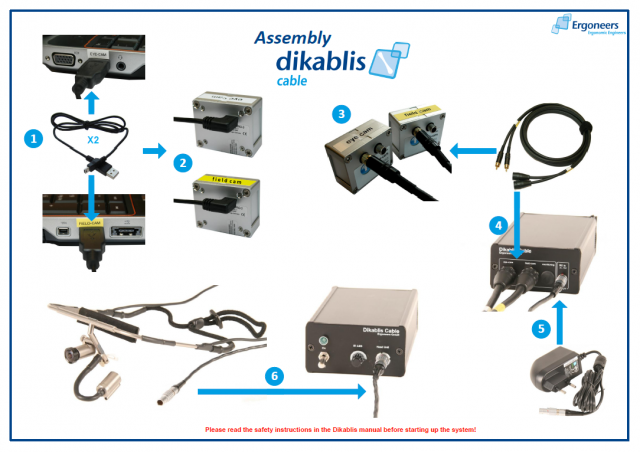
To start using the Dikablis, make sure the hardware is assembled as shown. Start up the laptop, and turn on the cable box (gently pull and switch the toggle). Make sure the recording license stick is plugged in, and open the recording software on the desktop.
Dikablis Software
The following programs are on the desktop of the Dell laptop: Dikablis Recorder 2.0, Dikablis Player 2.0, Dikablis Analysis 2.0, Control Center 1.0, Marker Detector 2.1, and D-Lab Essential 2.0. These are briefly described below, roughly in the order in which they would be run to test and then analyze one subject's data.
Although these programs can be installed on any computer using the Dikablis installation CD, the Recorder should only be used with the Dell laptop as it has been optimally configured for recording. Note also that the appropriate license stick must be plugged in to use all software except the Dikablis Player and Recorder.
Calibrating and Recording
Dikablis Recorder is used to calibrate eye-tracking and record eye-cam and field-cam videos during the testing session.
Before opening Dikablis Recorder, make sure that the hardware is assembled properly. If so, open Recorder and you should see video from the eye and/or field cams, and be able to switch or blend the videos using the visualization options in the lower-right panel. Make adjustments to the field camera so that it shows what the participants is seeing *link*.
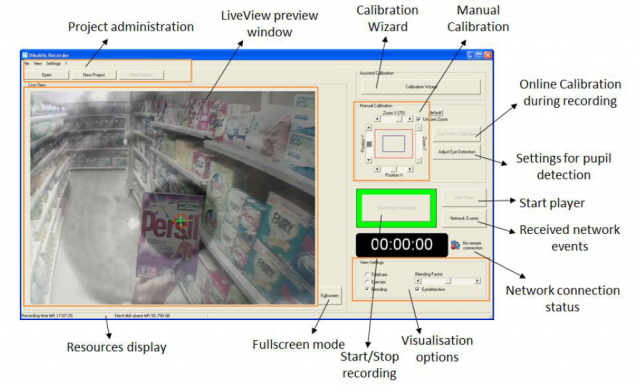
To begin testing a new subject, open an existing project or create a new one, then create a new subject within that project. Note: When creating a project, you can define triggers- timestamped events in the *.txt journal file, of key presses or network events- for all subjects in that project. However, these require manual analysis. If you need to send or receive events from another computer by network connection, you can connect an ethernet cable to that computer, then wait for network symbol to indicate 'connected'.
Next, start the calibration wizard. When instructed, adjust the eye-camera gently so that left pupil is centered in square (note: the eye-cam is meant to film only the left eye- don't try to bend it towards the right eye!). Next, you can mask dark areas such as eyelashes and set a threshold to optimize pupil detection. Have the participant look around to make sure the pupil is still detected. There's also an expert mode pupil detection option. Next, calibrate to synch up the eye and field cams by having the participant look at one point in each quadrant of the environment, and marking these points in the Recorder software with a mouse click. You should calibrate from the same distance as when testing. When you are done calibrating, click finish.
Press 'start record' when you want to start recording, and 'stop record' when your experiment ends. You can repeat to add further recordings to the participant. It is possible to manually recalibrate while recording- to do this, press "start online calibration". You may want to do this if, e.g., the headset shifts while testing.
Data is saved in the "online" folder of the subject specified. This is distinguised from the "offline" folder, which is where data is saved after offline editing. After recording, 3 files are saved to the online folder: the field-cam *.avi video, eye-cam *.avi video and a *.txt file with the prefix "journal" which includes keyboard and network event triggers. Note that videos exceeding 1GB in size are split up, but automatically put back together in the Player and Analyis software.
Dikablis Recorder Network Interface
The TCP/IP port can be configured to control the Dikablis Recorder from another computer over network. By default port 2002 is used for this. Journal data can be received over network by a second port, by default port 2002. These defaults (and journal data transmission) can be changed in the settings.xml file found in c:/Programs/Dikablis/Recorder
Playing Back
You can use Dikablis Player to play back the video you recorded using Dikablis Recorder. Note that this program is not used for analysis.
To start the Player after recording and automatically load the video just recorded, click the Start Player button in Dikablis Recorder. Otherwise click on Dikablis Player on the desktop.
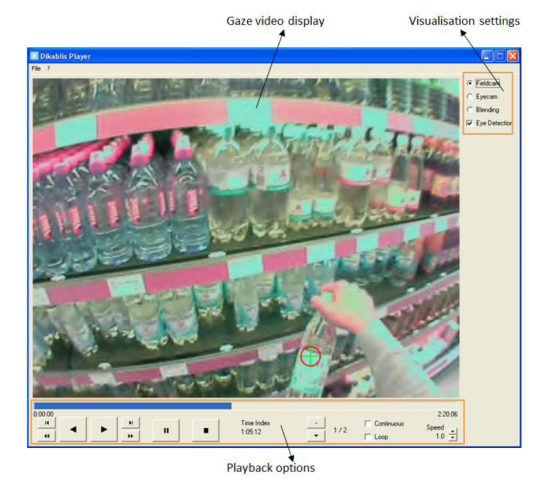
Check the "eye detection" box to show the focal point as a crosshair while playing video.
Dikablis Analysis
Dikablis Analysis software allows for post-hoc corrections in your calibration and pupil detection, as a preliminary step towards statistically analyzing your data with the D-Lab program. It also allows you to manually enter triggers while watching video if you intend to do statistical analysis outside of the D-Lab program.
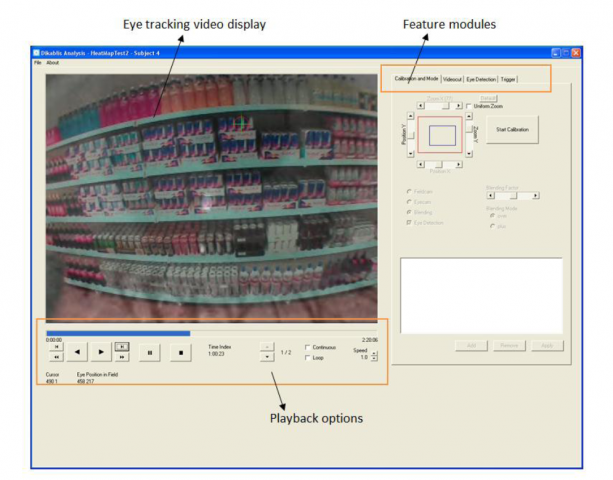
Manual Recalibration
You can manually recalibrate if the headgear shifted during the experiment and you know where subject looked during particular frame, e.g., fixation cross.
In the Dikablis Analysis software, first open the subject's data. Offline recalibration options are found under the "calibration and mode" feature module. Use the slider beneath the video to choose the frame which you want to recalibrate. Next, click on "start calibration". To activate the new calibration click "Add", and this configuration will appear in a list. From that point on in the video, the new calibration will be applied. This can be repeated for many frames. When done calibrating, click "stop calibration".
Optimizing Pupil Detection
The rate of successful pupil identifications (as a percent of all frames) is shown under the "eye detection" feature module. 94-96% is a good value, and steps taken under this tab can increase this value.
You can select automatic *link* or manual *link* pupil detection options. For both options, click the "invalid only" checkbox to only examine frames in which the pupil failed to be detected.
Manual Analysis with Triggers
The "trigger" feature module allows for manual analysis using the triggers specified in Recorder, and also allows you to change these triggers or to add new triggers.
For example, to add a new trigger whenever the person looks at an area of interest (AOI), you could define a new trigger defined by presses of the "T" key, and whenever the person's focus is on the AOI press "T". When the focus moves away from the AOI, press "T" again. A new column for this event will be added to the *.txt journal file. This file can then be read into statistical software for analysis. Note: as an alternative to this manual analysis, you can define AOIs using Dikablis D-Lab software for behaviour objectification. This option offers automatic analysis and statistical and graphical output.
Videocut
The "videocut" feature module allows you to create a video by cutting and pasting together different video sequences. You can use this to save a video with the crosshairs indicating gaze, for instance.
Note that when you save changes to data in the online folder of a subject, they are automatically saved to different files in that subject's offline folder.
Control Center
Control Center (called D-Lab Control in the reference manual) controls data acquisition. This program allows you to control the Recorder program based on testing procedures preconfigured in the D-Lab program. Furthermore, you can use Control Center on a computer other than the Dikablis laptop in order to control starting and stopping of recordingover a local network (ethernet) connection.
- used to stream data to another computer? configure which events get sent to network?
In order to control the Dikablis laptop's Recorder program on a second computer with an ethernet cable:
- Physically connect the ethernet cable
- Determine the local area IP address of the dikablis computer:
- Go to start, type in "cmd", and a command prompt will open
- Type "ipconfig /all"
- Look under Ethernet Adapter Local area connection, next to IPv4 address
- Open Recorder on the dikablis laptop
- Open Control Center on the second computer
- Under outgoing connection settings, type in the IP address of the dikablis comptuter, and use port "2001"
- Click on "Connect"
The red circle next to Outgoing connection settings should turn green, and you should be able to start and stop recording by pressing the corresponding buttons at the bottom of Control Center.
Note: Make sure the Recorder program on the Dikablis laptop is opened, as network communication occurs through this program.
Marker Detector
Markers are used as reference points in the environment, and are processed in the field video after recording using the Marker Detector program. These reference points are needed to define areas of interest (AOIs) and depict heat maps in the D-Lab software.
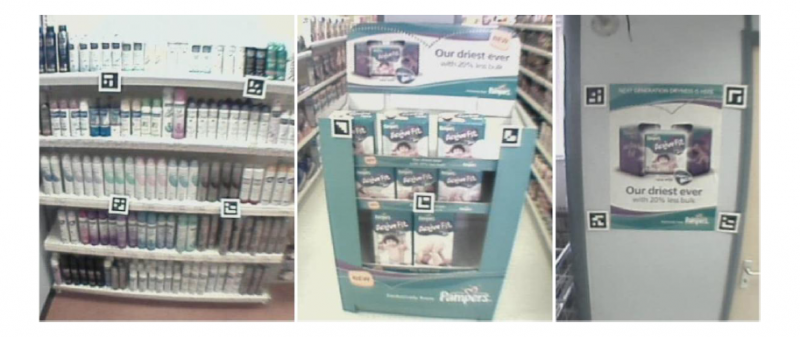
Open Marker Detector. Select the file or directory where the field video is located. Click start, and the markers in the video will be detected.
AOIs and Gaze Statistics
-dlab software -import dikablis- select a recording and scene in left panel, can analyze recalibrated files-can add area of interest either for whole project or particular subject, can calculate gaze statistics, e.g., how often/long looked at region -click new, define using left and right clicks, select marks, press ok -compute gaze behaviour
Q & A
Eye Control software: This is a new program that allows you to calculate in real time where someone is looking in marker-based coordinates. You can even define AOI based on marker coordinates and determine whether someone is looking at that AOI or not in real time. To do this, you first have to virtualize the environment/room by telling the software where the AOIs are. Note that the markers must be completely in view of the field camera, e.g,. no cables interposed. You can then stream out real time marker-based coordinates and AOI data via tcp/ip. For example, you can define an AOI called screen referring to a computer screen, then the tcp/ip output for that AOI will output "Area screen value: 1" when the subject is looking at the screen, and "Area screen value: 0" when not looking at it.
Q: With our current software, can we have triggers, eyedata, and marker-defined coordinate info all in the same file?
A: This info has to be in 2 files because the marker detector has to be run offline. You have to use post-hoc scripting to combine. Alternative is to use the Eye Control software, see above.
Q: How do we achieve best calibration?
A: Here's a few tips to help with calibration.
Generally, it's best to use the automatic calibration, and then manually adjust the achieved settings if needed to be more precise.
During the eye Camera Positioning part of the automatic calibration, have the participant track your finger from side to side horizontally, and make make sure the pupil remains within the horizontal lines.
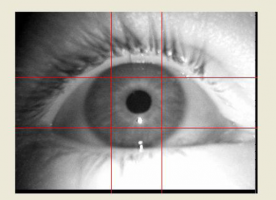
In the 'adjust eye detection' part of the calibration wizard, if the red 'x' indicating pupil position jumps back and forth and does not remain centered on pupil (e.g., while the participant is looking at a corner of the field), set the 'isolate pupil threshold' lower until only the pupil is coloured in red; then mark out the four quadrants again.
Once the calibration wizard is done, you can manually adjust the calibration using the calibration field in the Recorder window. Start with the default button, and make adjustments from there. If the zoom x value is too small, then horizontal eye movements will appear shorter than they actually are with the focus crosshair; vice versa when the zoom x value is too big- the crosshair will make bigger jumps than the eys actually make.
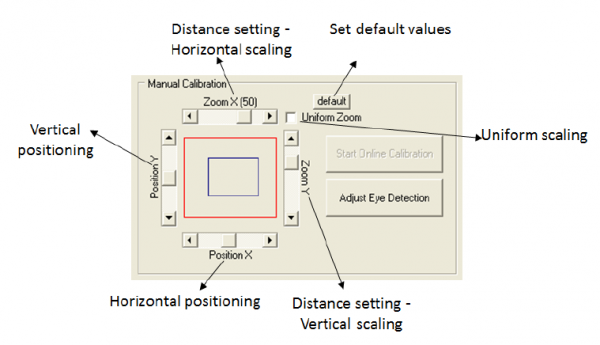
To test the quality of calibration, you can have the subject follow your finger and make sure the cross-hair in the video is following along closely with your finger.
Q: How do you calibrate when you are interested in planes at varying distances? E.g., reading distance and 10 meters away?
A: Start out by calibrating at a distance of ~2m, which is a good distance for generally calibrating. You can then calibrate at a second distance, but offline (i.e., after testing). While recording, have them look at things in closer plane: you should specify at least 2 points not in same x and y coordinate, i.e., misaligned. After recording, open the Dikablis Analysis software, find the frame(s) at this second distance where the subject is looking- then manually ?set horizontal and vertical jump?, and click add. Save this setting as e.g., 'short distance', and this saved calibration will automatically appear in that subject's offline folder in a file called short distance.
Q: How do you save video with crosshairs indicating the subject's focus?
A: Use video clip section in Dikablis Analysis program. You can specify how much to save, and paste together different segments of video into one video.
Q: How can I make the markers less noticable?
A: 20x20 pixels in field camera is smallest detectable size for markers. They don't need to be black and white, i.e., you can have different colours, but there needs to be contrast in the pattern.
Troubleshooting
Problem: Static image is showing in the eye cam video Answer: Make sure the usb cables from the eye cam (and field cam for that matter) are plugged directly into the laptop, not into a usb hub.
Problem: The Eye cam's video is dark, particularly as compared with the field cam video. Answer: Make sure the IR-LED infrared illumination dial on the cable box is set to the maximum level.